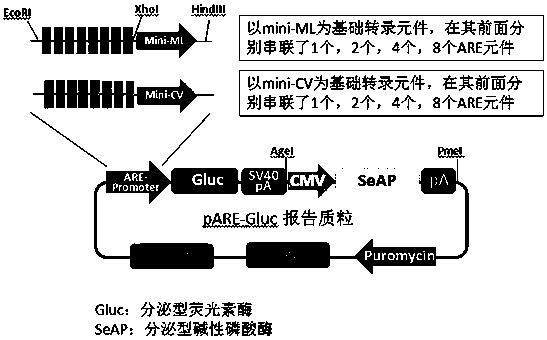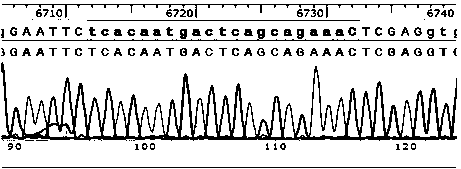Recombinant plasmid for screening nrf2 activator and its construction method and use
A recombinant plasmid and activator technology, applied in the field of biomedicine, can solve the problems of difficult long-term detection, complicated operation steps, unstable results, etc., and achieve the effects of long-term activity monitoring, simplified operation steps, and convenient and fast detection.
- Summary
- Abstract
- Description
- Claims
- Application Information
AI Technical Summary
Problems solved by technology
Method used
Image
Examples
Embodiment 1
[0036] Example 1: Construction method of recombinant plasmid
[0037] (1) Experimental materials
[0038] Plasmids, strains and cells HaCaT cells, secreted luciferase vector, Escherichia coli plasmid (purchased from Institute of Cell Research, Chinese Academy of Sciences, Shanghai).
[0039] Reagents: Secrete-Pair Dual Luminescence Assay Kit (purchased from Genecopoeai Company); lipofec3000 Liposome (purchased from Invitrogen Company).
[0040] Equipment: Infinite F200Pro multifunctional microplate reader (purchased from TECAN company), UV lamp tube (purchased from Philips company).
[0041] (2) Experimental steps
[0042]In this example, the secreted luciferase (Gaussia Luciferase, Gluc) derived from Gaussia princeps was used as the reporter gene, and the Nrf2 with easy detection, high sensitivity and high stability was constructed by screening the antioxidant response element (ARE). The reporting system for signaling pathway activation, the specific steps are as follows: ...
Embodiment 2
[0058] Embodiment 2: Identify the reactivity of the recombinant plasmid of embodiment 1 in cells with known Nrf2 activators
[0059] (1) HaCaT cells were cultured in DMEM medium supplemented with 100 U / ml penicillin, 100 μg / ml streptomycin and 10% fetal bovine serum at 37°C in an atmosphere containing 5% CO2, using Life Technologies (Carlsbad, CA, USA) Lipofectamine 2000 reagent purchased was used for the recombinant plasmid transfected cells prepared in Example 1 according to the recommended process;
[0060] (2) After 24 hours of transfection, replace the fresh medium containing SF (10uM) and tBHQ (20uM), and continue to cultivate for 24 hours;
[0061] (3) Take 100 ul of the medium supernatant for luciferase activity detection. The assay of each reporter activity used the Secrete-Pair Dual Luminescence Assay Kit of Genecopoeai Company and adopted the Infinite F200Pro multifunctional microplate reader of TECAN Company, and determined luciferase (Gluc) and alkaline phosphata...
Embodiment 3
[0063] Embodiment 3: Use the recombinant plasmid of embodiment 1 to detect the reactivity of known Nrf2 activators with different action times and the application of screening antioxidants
[0064] 1. Recombinant plasmids are used to detect the reactivity of known Nrf2 activators with different action times
[0065] (1) HaCaT cells were cultured in DMEM medium supplemented with 100 U / ml penicillin, 100 μg / ml streptomycin and 10% fetal bovine serum at 37°C in an atmosphere containing 5% CO2, using Life Technologies The Lipofectamine 2000 reagent purchased by the company (Carlsbad, CA, USA) was used in the p8XARE-ML-Gluc-AP-Puro plasmid transfected cells of Example 1 according to the recommended procedure;
[0066] (2) After 24 hours of transfection, fresh medium containing SF (10uM) and tBHQ (20uM) was replaced, and then 100ul medium supernatant was taken at 0, 6, and 24h for the detection of luciferase (Gluc) activity.
[0067] (3) The determination of the reactivity of known...
PUM
 Login to View More
Login to View More Abstract
Description
Claims
Application Information
 Login to View More
Login to View More - R&D
- Intellectual Property
- Life Sciences
- Materials
- Tech Scout
- Unparalleled Data Quality
- Higher Quality Content
- 60% Fewer Hallucinations
Browse by: Latest US Patents, China's latest patents, Technical Efficacy Thesaurus, Application Domain, Technology Topic, Popular Technical Reports.
© 2025 PatSnap. All rights reserved.Legal|Privacy policy|Modern Slavery Act Transparency Statement|Sitemap|About US| Contact US: help@patsnap.com



